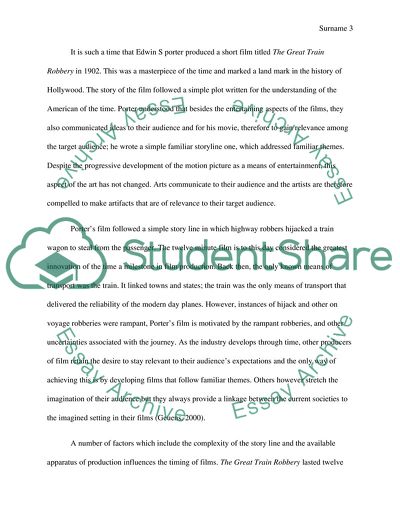Cite this document
(Issues in Film History Essay Example | Topics and Well Written Essays - 2250 words, n.d.)
Issues in Film History Essay Example | Topics and Well Written Essays - 2250 words. https://studentshare.org/visual-arts-film-studies/1796570-using-either-two-short-films-from-films-silent-period-pre-1929-or-one-short-film-and-an-extract-from-a-longer-film-both-of-which-should-also-be-pre-1929-discuss-what-they-can-tell-us-about-the-early-development-of-narrative-cinema-you-should-show
Issues in Film History Essay Example | Topics and Well Written Essays - 2250 words. https://studentshare.org/visual-arts-film-studies/1796570-using-either-two-short-films-from-films-silent-period-pre-1929-or-one-short-film-and-an-extract-from-a-longer-film-both-of-which-should-also-be-pre-1929-discuss-what-they-can-tell-us-about-the-early-development-of-narrative-cinema-you-should-show
(Issues in Film History Essay Example | Topics and Well Written Essays - 2250 Words)
Issues in Film History Essay Example | Topics and Well Written Essays - 2250 Words. https://studentshare.org/visual-arts-film-studies/1796570-using-either-two-short-films-from-films-silent-period-pre-1929-or-one-short-film-and-an-extract-from-a-longer-film-both-of-which-should-also-be-pre-1929-discuss-what-they-can-tell-us-about-the-early-development-of-narrative-cinema-you-should-show.
Issues in Film History Essay Example | Topics and Well Written Essays - 2250 Words. https://studentshare.org/visual-arts-film-studies/1796570-using-either-two-short-films-from-films-silent-period-pre-1929-or-one-short-film-and-an-extract-from-a-longer-film-both-of-which-should-also-be-pre-1929-discuss-what-they-can-tell-us-about-the-early-development-of-narrative-cinema-you-should-show.
“Issues in Film History Essay Example | Topics and Well Written Essays - 2250 Words”. https://studentshare.org/visual-arts-film-studies/1796570-using-either-two-short-films-from-films-silent-period-pre-1929-or-one-short-film-and-an-extract-from-a-longer-film-both-of-which-should-also-be-pre-1929-discuss-what-they-can-tell-us-about-the-early-development-of-narrative-cinema-you-should-show.


